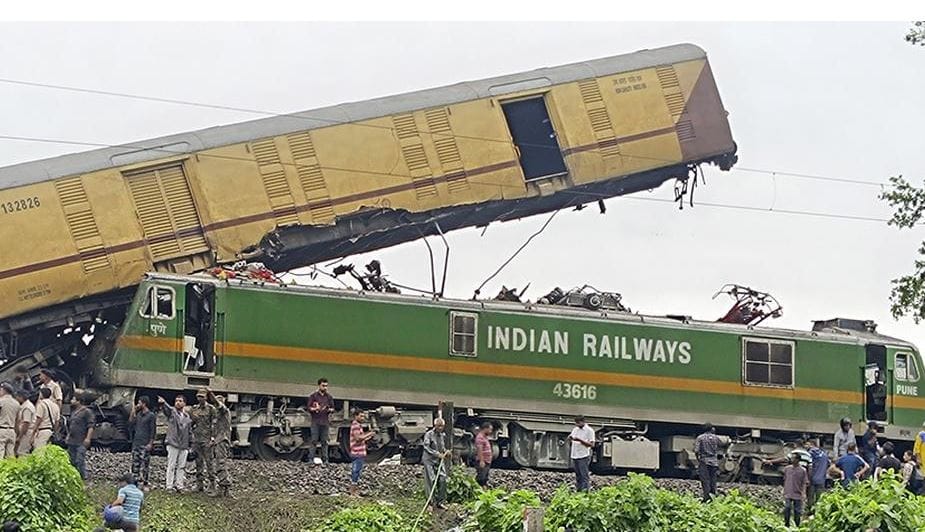An Inevitable Disaster
In a grievous mishap on June 17, 2024, the Kanchanjunga Express collided with a goods train near New Jalpaiguri station, West Bengal, leading to a catastrophic loss of ten lives, including the loco pilot of the goods train. The Commissioner of Railway Safety (CRS) has since released a damning report, highlighting multiple systemic failures and negligence at various levels that culminated in this tragedy.
The Alarming State of Signal Management
The CRS report underscores that the accident was “waiting to happen” due to lapses in managing train operations within automatic signaling zones. Critical to this assessment is the improper issuance of T/A 912 paper authority to the loco pilot of the goods train, which did not specify the speed limit to be adhered to while crossing defective signals. This glaring oversight reflects a broader issue of inadequate counseling and training for loco pilots and station masters on handling such scenarios.
Between the issuance of the defective signal and the collision, five other trains traversed the section. The Kanchanjunga Express was the only one that adhered to the prescribed norm of moving at a maximum speed of 15 kmph and stopping for one minute at each defective signal. The other trains, including the goods train, disregarded this rule, leading to confusion and inconsistency in handling defective signals.
The Demand for Advanced Safety Systems
The CRS has recommended the urgent implementation of the Automatic Train Protection (ATP) system known as KAVACH to prevent such incidents in the future. The report highlights that existing measures, including loco pilot counseling and safety drives, have proven insufficient. From April 1, 2019, to March 31, 2024, there were 208 instances of Signal Passing at Danger (SPAD), 12 of which resulted in collisions. This statistic alone underscores the dire need for more robust safety mechanisms.
The lack of critical safety equipment, such as walkie-talkies for the goods train crew, further exacerbated the situation. The Northeast Frontier Railway (NFR) Zone, under whose jurisdiction the accident occurred, failed to equip the crew with these essential tools.
Options Ignored Amidst Crisis
In the face of multiple signal failures, the rail administration had three potential options to mitigate risk, yet none were fully implemented. The first option was to adhere to the general rule, instructing loco pilots to stop the train for one minute at a defective signal before proceeding with caution. The second option involved issuing a T/A 912 form with a caution order specifying speed limits, which was neglected. Lastly, they could have treated the scenario as a “major signal failure” under the Automatic Block System, allowing only one train between two stations until the preceding train crossed the next station.
During the critical night of June 16-17, the control office at the divisional level was inadequately staffed with only a technician, rather than the requisite Senior Section Engineer, Junior Engineer, and helper. Despite the seriousness of the failure, higher officials at the Katihar division failed to respond appropriately, indicating a severe lack of accountability and responsiveness.
The Dire Need for Systemic Overhaul
Since the introduction of automatic signaling in January 2023, it has become imperative that all related rules are thoroughly implemented at the field level. However, the widespread misinterpretation of rules reveals a failure in establishing effective checks and balances at the headquarters level. The CRS report emphasizes the necessity for a systemic overhaul to ensure that such tragic incidents do not recur.
To summarize, the CRS report on the Kanchanjunga Express train accident lays bare the critical lapses and negligence at multiple levels of railway administration. The incident underscores the urgent need for implementing advanced safety systems like KAVACH and ensuring rigorous training and counseling for railway personnel. This tragic event serves as a stark reminder of the importance of stringent safety protocols and accountability in preventing future disasters.
Key Learning Points
| Key Points | Details |
|---|---|
| Cause of Accident | Multiple systemic failures and lapses in signal management |
| Fatalities | Ten people, including the loco pilot of the goods train |
| Primary Issue | Improper issuance of T/A 912 without speed specification |
| Safety Recommendations | Urgent implementation of KAVACH ATP system |
| Negligence Highlighted | Inadequate staffing and oversight at control offices |
| Preventive Measures Suggested | Proper training and counseling for loco pilots and station masters |
Summary
The Kanchanjunga Express train accident in West Bengal, resulting in ten fatalities, has been attributed to significant lapses in signal management and inadequate training of railway personnel. The CRS report emphasizes the need for implementing the KAVACH Automatic Train Protection system and improving safety protocols to prevent future tragedies.
Soumya Smruti Sahoo is a seasoned journalist with extensive experience in both international and Indian news writing. With a sharp analytical mind and a dedication to uncovering the truth, Soumya has built a reputation for delivering in-depth, well-researched articles that provide readers with a clear understanding of complex global and domestic issues. Her work reflects a deep commitment to journalistic integrity, making her a trusted source for accurate and insightful news coverage.



